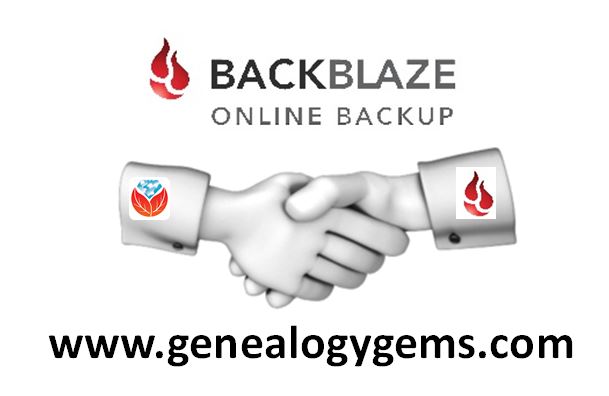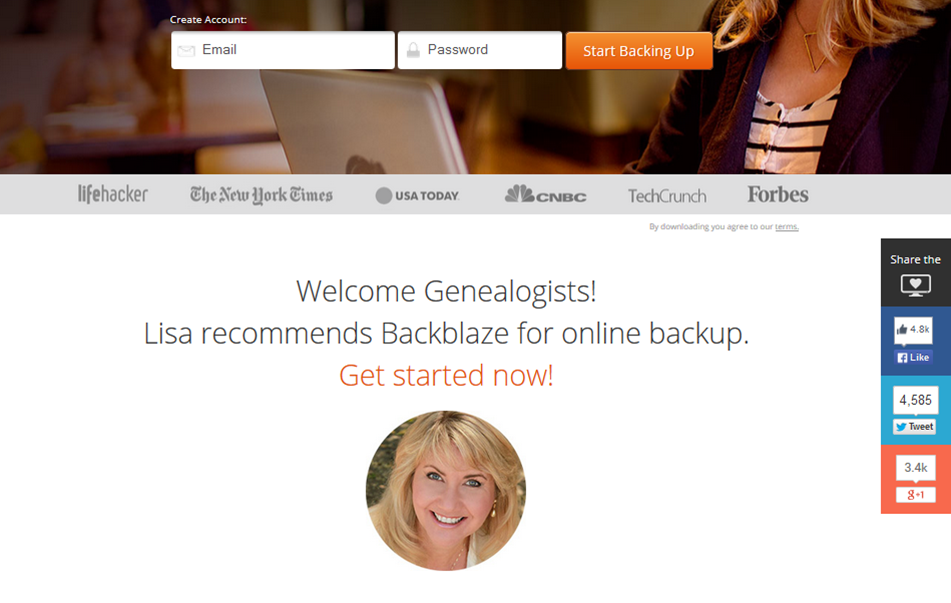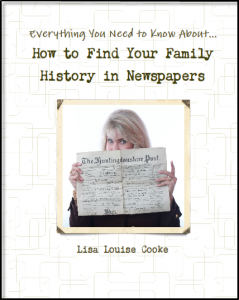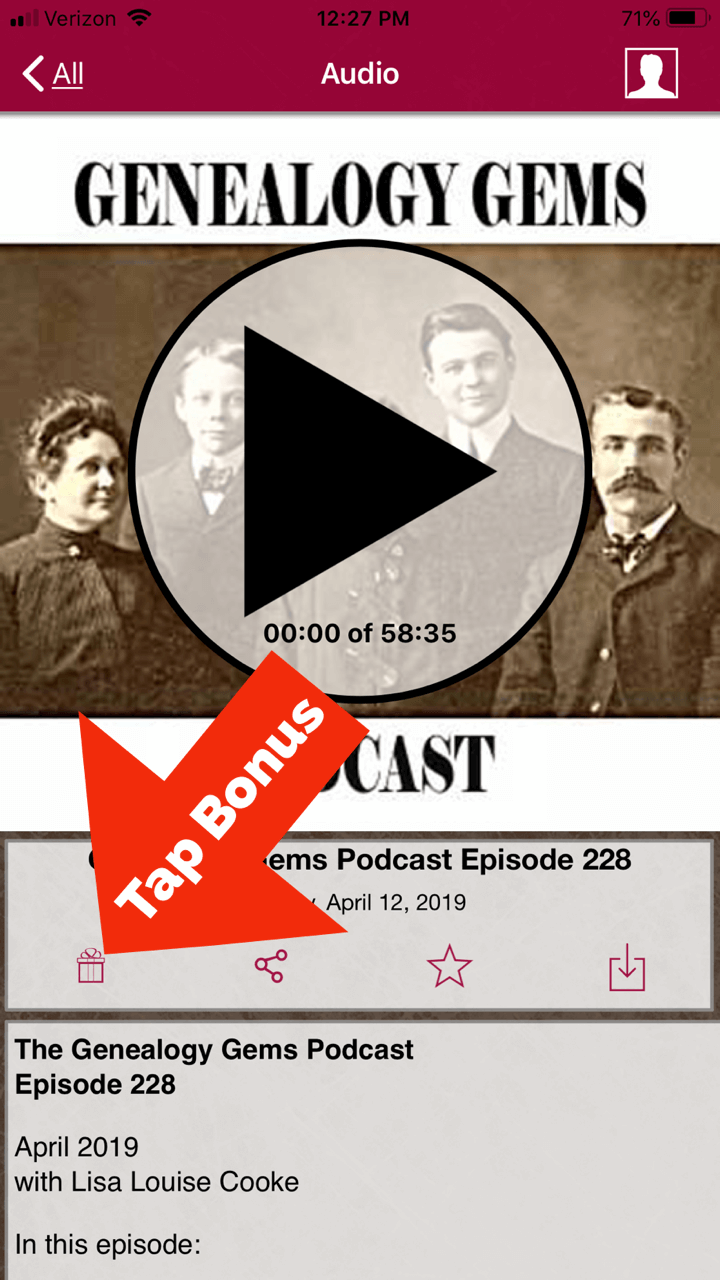by Lisa Cooke | Jun 11, 2015
 In the last year I’ve moved from Earthquake Central (California) to Tornado Alley (Texas) and it’s been a bit of an adjustment, to say the least! Recently I presented a live webinar on using Evernote for genealogy during a tornado watch, with my husband fretting in the background. Not long after, we spent an hour in our shelter room during torrential rains, non-stop lightning, and nearby tornado touchdowns.
In the last year I’ve moved from Earthquake Central (California) to Tornado Alley (Texas) and it’s been a bit of an adjustment, to say the least! Recently I presented a live webinar on using Evernote for genealogy during a tornado watch, with my husband fretting in the background. Not long after, we spent an hour in our shelter room during torrential rains, non-stop lightning, and nearby tornado touchdowns.
All this threat of danger and destruction has reinforced my decision to bring into our Genealogy Gems family a brand new sponsor. Backblaze is now the official back up of Lisa Louise Cooke’s Genealogy Gems. Backblaze isn’t new to the genealogy space: if you’ve been to RootsTech, you’ve likely seen their booth. Backblaze is a trusted online cloud backup service that truly makes backing up all your most precious computer files super easy.
Many of you have asked me which company I use to back up my files. I’ve done my homework and Backblaze is my choice. The thought of losing my genealogy files is too much to bear. Now I can concentrate on keeping my loved ones safe through the storms of life because I know Backblaze is taking care of my files and photos! A few things to consider:
- They back up ALL your files (or just those you select). Music, photos, data, documents, etc.
- You have an unlimited amount of data storage on Backblaze.
- In the event you lose data, you can download from any computer or have a hard drive FedExed to you.
- For the price of a single average hard drive restoration (when it’s even possible), Backblaze could back up your computer for 50 years.
- External drives are great, but if they’re sitting next to your computer, they would be lost in a natural disaster, too.
- Backblaze serves both Mac and PC owners.
- You can get started for free. And then it’s really inexpensive to have them continuously back you up. Only $5 per month, last we checked, or $50 for an entire year.
 I invite you to visit www.Backblaze.com/Lisa and get all your files backed up once and for all!
I invite you to visit www.Backblaze.com/Lisa and get all your files backed up once and for all!
by Diahan Southard | Jul 1, 2014 | 01 What's New, Trees

Easy or complicated genealogy for the folks on this remote island? Tristan da Cunha, Wikipedia image.
Small, isolated populations should mean it’s easy to do their genealogy, right? Well, I wonder.
I came across this Wikipedia article on Tristan da Cunha, described as “the most remote inhabited island in the world, lying 1,750 miles from the nearest landfall in South Africa, and 2,088 miles from South America. Its current population of 264 is thought to have descended from 15 ancestors, 8 males and 7 females, who arrived on the island at various times between 1816 and 1908. The male founders originated from Scotland, England, the Netherlands, United States and Italy and the island’s 80 families share just eight surnames: Glass, Green, Hagan, Lavarello, Patterson, Repetto, Rogers, and Swain.”
Of course, success in doing family history on this island depends a lot on how strong their record-keeping and preservation has been. (Consider what one natural disaster could do to written history) Barriers to migration should certainly mean it’s easy to find ancestors. But what does that family tree look like? How many people will show up in multiple places on the tree?
Have you ever done genealogy research on an isolated or insular group? What are the challenges? What’s easier? Feel free to share on the Genealogy Gems Facebook page. Feel free to share your tales of complicated genealogy!
by Lisa Cooke | Aug 15, 2013 | 01 What's New, Newspaper
Have you already searched for your relatives’ names at Chronicling America, the the Library of Congress’ web collection of digitized American newspapers? Well, search again!
Recently the the Library of Congress added more than 600,000 historic newspaper pages to its enormous collection. According to a press release, these pages include “first-time contributions from Iowa, Michigan, and West Virginia. Other new additions include content from Hawaii, Indiana, Illinois, Kansas, Kentucky, Louisiana, Minnesota, Montana, North Dakota, Oklahoma, Oregon, South Carolina, Tennessee, and Texas.” The site now has over 6.6 million searchable newspaper pages from over 1100 newspaper titles, published in 30 states and Washington, D.C. between 1836 and 1922.
 What are the chances your family will appear on one of those pages? Pretty good, actually. Here’s a list of the kinds of articles they may show up in from my book How to Find Your Family History in Newspapers:
What are the chances your family will appear on one of those pages? Pretty good, actually. Here’s a list of the kinds of articles they may show up in from my book How to Find Your Family History in Newspapers:
- Advertising: classifieds, companies your ancestor worked for or owned, grocery or dry goods stores ads (for historical context), runaway slaves search and reward, ship departures.
- Births & deaths: birth announcements, card of thanks printed by the family, obituary and death notices, “Community Pioneer” article upon passing, funeral notice, reporting of the event that lead to the death, or the funeral.
- Legal notices and public announcements: auctions, bankruptcies, city council meetings, divorce filings, estate sales, executions and punishments, lawsuits, marriage licenses, probate notices tax seizures, sheriff’s sale lists.
- Lists: disaster victims, hotel registrations, juror’s and judicial reporting, letters left in the post office, military lists, newly naturalized citizens, passenger lists (immigrants and travelers), unclaimed mail notices.
- News articles: accidents, fires, etc. featuring your ancestor; front page (for the big picture); industry news (related to occupations); natural disasters in the area; shipping news; social history articles.
- Community and social events like school graduations, honor rolls, sporting and theater events; social news like anniversaries, church events, clubs, engagements, family reunions, visiting relatives, parties, travel, gossip columns, illnesses, weddings and marriage announcements.
Learn more about researching family history with my book, available in both print and e-book format. And don’t forget to keep checking Chronicling America for stories and clues about your ancestors’ lives.
by Lisa Cooke | May 23, 2019 | 01 What's New, Genealogy Gems Podcast |
with Lisa Louise Cooke
May 2019
Listen now, click player below:
Download the episode (mp3)
In this episode:
- Two listeners shares an exciting find using Lisa’s research strategies
- Lisa provides next steps on German research in response to a listener question
- Your Master Family Tree, and Sharing Branches Online Explained
- The unusual history of one of the earliest forms of the World Wide Web
NEWS:
Lisa Louise Cooke is back in the studio after two weeks on the road speaking at the Ohio Genealogical Society (OGS) Conference and the National Genealogical Society (NGS) Conference.
Each conference was great and had its own unique feel, and there were many new genealogists in attendance.
Genealogy Gems listener Carol stopped by and enthusiastically shared with how the eBay search strategies for family history that Lisa discussed in episode 140 paid off in a big way!


MAILBOX:

Robin wrote in to share how Sydney Orton’s song with her grandpa in Genealogy Gems Podcast episode 228 brought her to tears in a toll plaza while driving!
Steve wrote in to rave about the value that his new Genealogy Gems Premium eLearning membership has brought to his family history research.
Rylee says she’s grateful to have found the podcast and she shares a story of genealogical discovery that she hopes will inspire others. Rylee asks “How do I find sources for these people? I have searched all over ancestry and Family Search and have had no luck again. I really want to believe that the people I have as Adam’s parents and siblings all the way through his 2nd great-grandparents (paternal) are truly his family but I need to get more information. Where can I go for help with German records and where can I continue my search?”
Lisa’s comments: You’re absolutely right, what you found are just hints. It sounds like it’s time for you to move on from the “Genealogy Giants” (Ancestry, FamilySearch, etc.) and into German records websites, libraries, and archives to find real sources that nail down the family tree.
Lisa recommends the Genealogy Giants quick reference comparison guide.
We have several articles and episodes at Genealogy Gems that can help you do this:
- Go to genealogygems.com
- At the top of the home page select “German” from the “Start Learning” drop down menu
- That will take you to these results pages featuring our German research strategies.
I’m optimistic for you because Germans are known for keeping excellent records, and I have had good luck in searching them.
GEM: Your Master Family Tree, and Sharing Branches Online Explained

I describe it this way: Plant your tree in your own backyard and share branches online.
A master family tree has three important characteristics:
- It is owned and controlled by you.
- It is the final say on what you currently know about your family tree.
- It is protected with online backup to ensure it is safe.
Plant Your Master Family Tree
Lisa uses RootsMagic software for her master family tree. Learn more about GEDCOM files in this article: GEDCOM File (What is It & How to Use This Genealogy File)
Protech Your Master Family Tree
Lisa uses Backblaze to back up her master family tree and computer. Visit www.backblaze.com/lisa
(Using this link also helps keep this free podcast free. Thank you!)
Read more: How to Download Backblaze in 4 Easy Steps

Share Branches Online
Genealogy Giants Guide available in the Genealogy Gems store.

Read Lisa’s article: Planting Your Master Genealogy Family Tree for all of the strategies mentioned in this episode.
The free podcast is sponsored by:


PROFILE AMERICA: Friday, May 24th, 2019
In a way, today marks the 175th birthday of the World Wide Web. Only it was electro-mechanical, not digital. On this date in 1844, Samuel F.B. Morse activated the first telegraph line, sending a dots-and-dashes code message from the U.S. Capitol building to a receiver in Baltimore.
By the late 1850s, the first telegraph cable had been laid across the Atlantic Ocean, and in 1861, the telegraph spanned the continental United States. Over the ensuing decades, the wires wrapped around the world.
From the 1844 demonstration, telecommunications today has grown into a half-trillion dollar a year industry, and employs more than 1 million workers in over 59,000 industry establishments.
You can find more facts about America from the U.S. Census Bureau online at www.census.gov.
Sources:
Joseph Nathan Kane, Kane’s Famous First Facts, Fifth Edition, H.W. Wilson Co., New York, NY, 1997, #7692.
Become a Genealogy Gems Premium eLearning Member

Gain access to the complete Premium Podcast archive of over 150 episodes and more than 50 video webinars, including Lisa Louise Cooke’s newest video The Big Picture in Little Details.
Learn more here.
(Membership doesn’t auto-renew because we don’t like that either. Prior to your membership expiring you’ll receive a friendly reminder email from us.)
Genealogy Gems App Users
Don’t miss the bonus content in this episode. Tap the “gift” icon on the episode screen in the app.
Get the app here or search for “Genealogy Gems” in your device’s app store.
Download the Show Notes PDF in the Genealogy Gems Podcast app.

 In the last year I’ve moved from Earthquake Central (California) to Tornado Alley (Texas) and it’s been a bit of an adjustment, to say the least! Recently I presented a live webinar on using Evernote for genealogy during a tornado watch, with my husband fretting in the background. Not long after, we spent an hour in our shelter room during torrential rains, non-stop lightning, and nearby tornado touchdowns.
In the last year I’ve moved from Earthquake Central (California) to Tornado Alley (Texas) and it’s been a bit of an adjustment, to say the least! Recently I presented a live webinar on using Evernote for genealogy during a tornado watch, with my husband fretting in the background. Not long after, we spent an hour in our shelter room during torrential rains, non-stop lightning, and nearby tornado touchdowns. I invite you to visit www.Backblaze.com/Lisa and get all your files backed up once and for all!
I invite you to visit www.Backblaze.com/Lisa and get all your files backed up once and for all!










